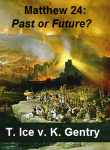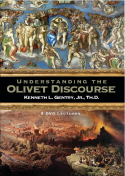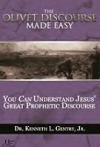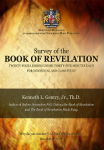FOUR DISCIPLES; TWO QUESTIONS
 PMW 2024-015 by Kenneth L. Gentry, Jr.
PMW 2024-015 by Kenneth L. Gentry, Jr.
An Important Question
A reader of my blog wrote and asked an important question:
“Hello, and thanks for the interesting blog posts!
I have a question concerning the amount of the questions Jesus’ disciples asked him in Matthew’s version of the Olivet Discourse.
Those who reject the preteristic interpretation of the discourse, argue that disciples asked three questions:
1) when will these things be (the destruction of the temple, which they admit that Jesus talks a bit)
2) what will be the sign of your coming (the second advent)
3) what will be the sign of the end of age (the end of the present world order we all are living)
My question: Is there any grammatical or other structural arguments for two and not three questions?
The Proper Answer
In Mark 13 we learn that four disciples come to Jesus and privately ask him the questions that spark the Olivet Discourse: “As He was sitting on the Mount of Olives opposite the temple, Peter and James and John and Andrew were questioning Him privately” (Mark 13:3). The number and identify of these disciples are glossed over in Matthew’s fuller version of the Discourse. Their fuller question is recorded in Matthew 24:3, which reads:
“As He was sitting on the Mount of Olives, the disciples came to Him privately, saying, ‘Tell us, when will these things happen, and what will be the sign of Your coming, and of the [a]end of the age?’”

Matthew 24 Debate: Past or Future?
(DVD by Ken Gentry and Thomas Ice)
Two hour public debate between Ken Gentry and Thomas Ice on the Olivet Discourse.
See more study materials at: www.KennethGentry.com
Unfortunately, many Christians believe their question involves three issues, whereas they actually involve only two. Let me explain.
Grammatically, we must note that the disciples are asking two questions: “Tell us, [1] when will these things be, and [2] what will be the sign of Your coming [parousia] and of the end [sunteleia] of the age?” (Matt. 24:3). The two interrogatives in Greek (pote, “when” and ti, “what”) show that two questions are being asked, not three.
Furthermore, the second question has three features that show that only one additional question is being asked. The first two features are grammatical; the last one is syntactical:
1. The second interrogative is ti (“what”). It governs the whole remainder of the sentence : “what will be … the sign of Your coming and of the end of the age”? No additional interrogative appears in the question. There are only two interrogatives because there are only two questions.
2. The singular form of the word “sign” (semeion) speaks of only one remaining issue. Their question involves only one “sign” (singular). This is true even though the one singular “sign” points to a compound event. Of what is this a sign? This singular sign points to “Your-coming-and-of-the-end-of-the-age.” That is, it is one sign referring to only one eschatological episode. This is because the coming of Christ marks the end of the age.
Understanding the Olivet Discourse 
By Ken Gentry
This 5 DVD lecture set was filmed at a Bible Conference in Florida. It explains the entire Olivet Discourse in Matt. 24–25 from the (orthodox) preterist perspective. This lecture series begins by carefully analyzing Matt. 24:3, which establishes the two-part structure of the Discourse. It shows that the first section of the Discourse (Matt. 24:4–35) deals with the coming destruction of the temple and Jerusalem in AD 70. This important prophetic event is also theologically linked to the Final Judgment at the end of history, toward which AD 70 is a distant pointer.
For more educational materials: www. KennethGentry.com
Now syntactically, the feminine singular genitive definite article tes (“the”) controls both the words parousia and sunteleias: “the … sign of Your-coming-and-of-the-end-of-the-age.” The second term sunteleias lacks a resumptive article. The Granville Sharpe Rule of the Article in Greek reads: when two singular common nouns are used to describe a person or thing, and those two nouns are in the same case and are joined by a conjunction, and the definite article precedes the first noun but not the second, then both nouns refer to the same things.
This being the case, Jesus’ parousia is linked with “the end of the age,” i.e., the end of temporal history. (I have other articles pointing out that “the end of the age” is the end of history and not the end of the old covenant era. And I am working on a book on that very topic, which is so prominent in Reformed theology.)
Thus, “Jesus separates what the disciples had joined together.” Because of this, “the key to the structure of this discourse on the Mount of Olives is the disciples’ double question in 24:3.” Though the disciples assumed the destruction of the temple and the parousia were concurrent, a proper understanding of the structure of Matthew 24 shows that Jesus did not accept their connection. Consequently, how these verses are understood controls how one understands the structure of the entire discourse. So then, with these two questions (“when” and “what”), the disciples are showing their confusion: they are asking about the time of the temple’s destruction, as if it will involve his second coming which ends universal history. (See my other articles pointing out the disciples’ general tendency to confusion, and especially their clear confusion here in asking their questions.)
Click on the following images for more information on these studies:



Kenneth L. Gentry Jr.'s Blog
- Kenneth L. Gentry Jr.'s profile
- 85 followers



